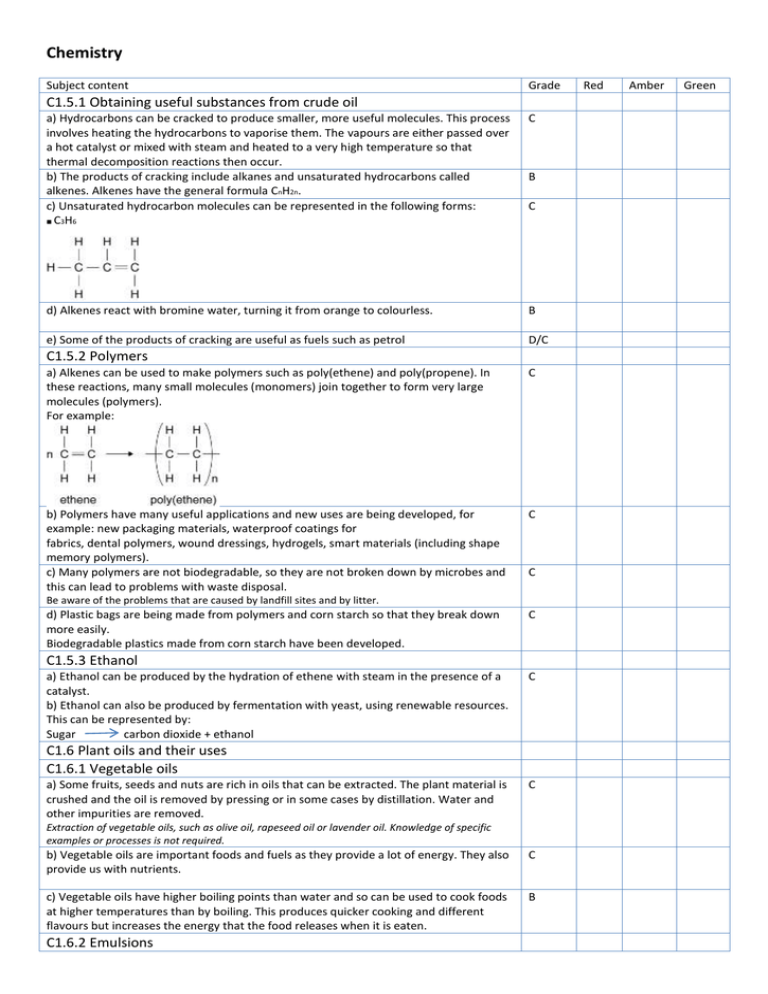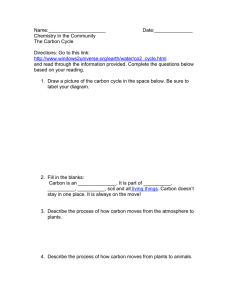Chemistry - Edublogs
advertisement

Chemistry Subject content Grade C1.5.1 Obtaining useful substances from crude oil a) Hydrocarbons can be cracked to produce smaller, more useful molecules. This process involves heating the hydrocarbons to vaporise them. The vapours are either passed over a hot catalyst or mixed with steam and heated to a very high temperature so that thermal decomposition reactions then occur. b) The products of cracking include alkanes and unsaturated hydrocarbons called alkenes. Alkenes have the general formula CnH2n. c) Unsaturated hydrocarbon molecules can be represented in the following forms: ■ C3H6 C d) Alkenes react with bromine water, turning it from orange to colourless. B e) Some of the products of cracking are useful as fuels such as petrol D/C B C C1.5.2 Polymers a) Alkenes can be used to make polymers such as poly(ethene) and poly(propene). In these reactions, many small molecules (monomers) join together to form very large molecules (polymers). For example: C b) Polymers have many useful applications and new uses are being developed, for example: new packaging materials, waterproof coatings for fabrics, dental polymers, wound dressings, hydrogels, smart materials (including shape memory polymers). c) Many polymers are not biodegradable, so they are not broken down by microbes and this can lead to problems with waste disposal. C C Be aware of the problems that are caused by landfill sites and by litter. d) Plastic bags are being made from polymers and corn starch so that they break down more easily. Biodegradable plastics made from corn starch have been developed. C C1.5.3 Ethanol a) Ethanol can be produced by the hydration of ethene with steam in the presence of a catalyst. b) Ethanol can also be produced by fermentation with yeast, using renewable resources. This can be represented by: Sugar carbon dioxide + ethanol C C1.6 Plant oils and their uses C1.6.1 Vegetable oils a) Some fruits, seeds and nuts are rich in oils that can be extracted. The plant material is crushed and the oil is removed by pressing or in some cases by distillation. Water and other impurities are removed. C Extraction of vegetable oils, such as olive oil, rapeseed oil or lavender oil. Knowledge of specific examples or processes is not required. b) Vegetable oils are important foods and fuels as they provide a lot of energy. They also provide us with nutrients. C c) Vegetable oils have higher boiling points than water and so can be used to cook foods at higher temperatures than by boiling. This produces quicker cooking and different flavours but increases the energy that the food releases when it is eaten. B C1.6.2 Emulsions Red Amber Green a) Oils do not dissolve in water. They can be used to produce emulsions. Emulsions are thicker than oil or water and have many uses that depend on their special properties. They provide better texture, coating ability and appearance, for example in salad dressings, ice creams, cosmetics and paints. B b) Emulsifiers have hydrophilic and hydrophobic properties A/A* C1.6.3 Saturated and unsaturated oils a) Vegetable oils that are unsaturated contain double carbon–carbon bonds. These can be detected by reacting with bromine water. C/B Candidates should be familiar with a test for unsaturation using bromine water. b) Vegetable oils that are unsaturated can be hardened by reacting them with hydrogen in the presence of a nickel catalyst at about 60°C. Hydrogen adds to the carbon–carbon double bonds. The hydrogenated oils have higher melting points so they are solids at room temperature, making them useful as spreads and in cakes and pastries. A/A* C1.7 Changes in the Earth and its atmosphere ■ recognise that the Earth’s crust, the atmosphere and the oceans are the only source of minerals and other resources that humans need ■ explain why Wegener’s theory of crustal movement (continental drift) was not generally accepted for many years C B Candidates should have studied accounts of Wegener’s work. Knowledge is limited to the theories relating to mountain building and continental drift. Candidates should know that scientists once thought that the features of the Earth’s surface were the result of the shrinking of the crust as the Earth cooled down following its formation. ■ explain why scientists cannot accurately predict when earthquakes and volcanic eruptions will occur ■ explain and evaluate theories of the changes that have occurred and are occurring in the Earth’s atmosphere ■ explain and evaluate the effects of human activities on the atmosphere ■ describe why we do not know how life was first formed. B B B A/A* C1.7.1 The Earth’s crust a) The Earth consists of a core, mantle and crust, and is surrounded by the atmosphere. b) The Earth’s crust and the upper part of the mantle are cracked into a number of large pieces (tectonic plates). c) Convection currents within the Earth’s mantle driven by heat released by natural radioactive processes cause the plates to move at relative speeds of a few centimetres per year. D/C C B Candidates should know that the mantle is mostly solid, but that it is able to move slowly. d) The movements can be sudden and disastrous. Earthquakes and / or volcanic eruptions occur at the boundaries between tectonic plates. B C1.7.2 The Earth’s atmosphere a) For 200 million years, the proportions of different gases in the atmosphere have been much the same as they are today: ■ about four-fifths (80%) nitrogen ■ about one-fifth (20%) oxygen ■ small proportions of various other gases, including carbon dioxide, water vapour and noble gases. b) During the first billion years of the Earth’s existence there was intense volcanic activity. This activity released the gases that formed the early atmosphere and water vapour that condensed to form the oceans. c) There are several theories about how the atmosphere was formed. D/C C C/B One theory suggests that during this period the Earth’s atmosphere was mainly carbon dioxide and there would have been little or no oxygen gas (like the atmospheres of Mars and Venus today). There may also have been water vapour and small proportions of methane and ammonia. d) There are many theories as to how life was formed billions of years ago. C e) One theory as to how life was formed involves the interaction between hydrocarbons, ammonia and lightning. A/A* Candidates should be aware of the Miller Urey experiment and the ‘primordial soup’ theory, but they should know that this is not the only theory. f) Plants and algae produced the oxygen that is now in the atmosphere. C Candidates should be aware that plants and algae produce oxygen by a process called photosynthesis and that this process uses carbon dioxide from the atmosphere. g) Most of the carbon from the carbon dioxide in the air gradually became locked up in sedimentary rocks as carbonates and fossil fuels. C Candidates should know that carbon dioxide dissolves in the oceans and that limestone was formed from the shells and skeletons of marine organisms. Fossil fuels contain carbon and hydrocarbons that are the remains of plants and animals. h) The oceans also act as a reservoir for carbon dioxide but increased amounts of carbon dioxide absorbed by the oceans has an impact on the marine environment. B i)Nowadays the release of carbon dioxide by burning fossil fuels increases the level of carbon dioxide in the atmosphere. B Candidates should be aware that this increase in carbon dioxide is thought to be causing global warming but, for this unit, candidates do not need to know how CO2 causes this effect. j) Air is a mixture of gases with different boiling points and can be fractionally distilled to provide a source of raw materials used in a variety of industrial processes. A/A*







